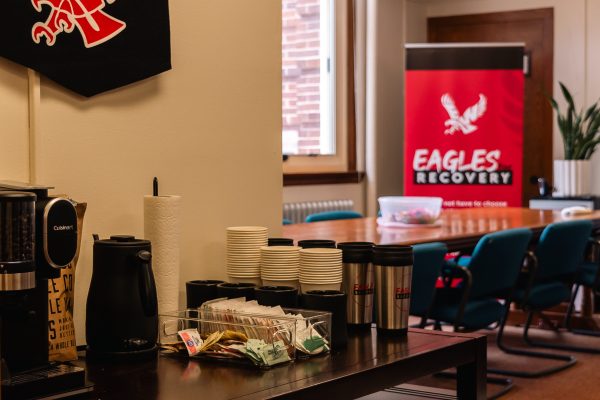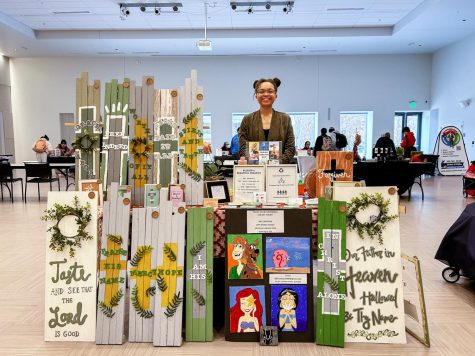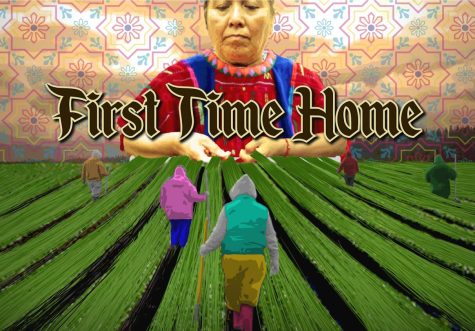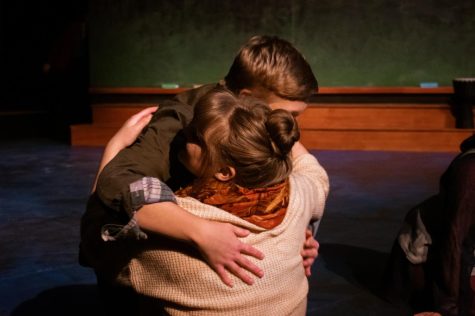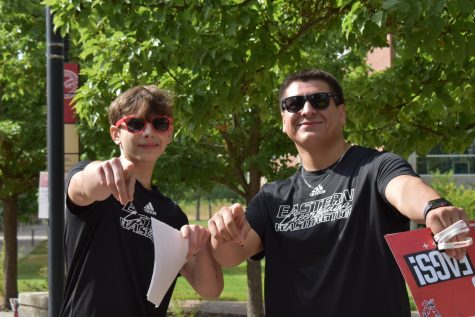Author’s new book: “The World Until Yesterday”
Jared Diamond spoke on human evolution, adaptation and changing societies
EWU guest speaker Jared Diamond presenting at the Fox Theater, Spokane.
May 7, 2015
Traditional societies have existed for thousands of years — some of these ancient cultures have faded into the fossils of the earth and the writing on the walls, while some have survived and still others have flourished.
Jared Diamond, author of “The World Until Yesterday,” raised a profound and demanding question: Why?
Many students and citizens of Spokane attended a lecture administered by Jared Diamond as he attended EWU campus and The Fox Theater in downtown Spokane for two separate lectures on April 23.
Diamond is an esteemed author of multiple books including “Collapse” and Pulitzer Prize-winning “Guns, Germs and Steel” — however, the focus of his lectures was on his newest book entitled “The World Until Yesterday.”
Jared Diamond is currently a professor at the University of California in L.A., and he specializes in multiple fields, including physiology, biophysics, history, ecology and geography — but most notable perhaps is his work in anthropology.
It was this anthropological insight that inspired him during one of 28 trips to Papua New Guinea. He went to bird watch because he is an avid ornithologist.
While on an outing with a few native New Guineans, Diamond attempted to set up camp underneath a large tree. Fearful, Diamond’s companions asserted their desire to sleep far from the base of the tree.
Initially, this paralyzing fear of sleeping under a tree might seem unmitigated, or perhaps even delusionally paranoid, but there is reasoning.
Every night, one might hear a crash in the thickets of the jungle; this crash announces the natural felling of these trees. That is but one or so tree a night in a whole jungle; however, given the consistency at which native New Guineans must camp outdoors, the odds are against them. Over the centuries, these native people have adapted and learned: Don’t sleep under the trees.
Diamond defined this adaptability as constructive paranoia, or rather an adaption to the environment. By learning from others’ uncautious follies, a new pattern of behavior emerged to eliminate mortal threats.
Traditional societies — societies that have existed for over 5,000 years — face multiple dangers every day: disease, violence, starvation, wildlife and even falling trees. Through adaptability, Diamond has pointed out that “the number of deaths of a hazard do not necessarily represent the danger of that hazard.”
For example, lions are significantly dangerous to multiple traditional societies, and yet, according to Diamond, they kill less than a hundred people per year worldwide, and even less than that in traditional societies.
Why is this? Humans adapt — especially to their environment. The natives of these ancient lands have learned to live their lives a specific way to avoid such a threat: Don’t go out after dark, walk in groups, talk constantly and so on.
The dangers we face in cultured societies are profoundly different — worlds apart.
Due to the comfort of our lives in a first-world civilization, we do not think long on common dangers.
But we face dangers every day: riding a bike, driving a car, drinking heavily, smoking, operating home appliances, accidentally strangling ourselves in our sleep and even taking a shower. According to the National Safety Council, odds are 1 in 6,000 a slip in the shower will kill you.
When we think of dangers, however, we don’t think of walking along the street as being a danger, of which the odds of being struck as a pedestrian are 1 in 600.
Instead, Americans tend to list superficial dangers implanted by the media such as terrorists, nuclear attacks, inorganic chemicals and plane crashes — all of which are, according to Diamond, grossly overestimated by the typical American.
Diamond urges us to pay close attention to things that carry a small risk of killing you each time you do them, but that you do often.
This is how traditional societies have coped with the dangerous elements of the world for over 5,000 year. Constructive paranoia is what has brought humans this far.
Diamond said, “Traditional societies represent thousands of natural experiments… on how to deal with universal problems and local dangers.”
Diamond concluded his lecture by revealing a rather disturbing statistic: Approximately 95 percent of Americans will die from noncommunicable diseases that are a result of our lifestyles. This includes cardiovascular diseases, cancers, diabetes and chronic respiratory diseases, all of which account for almost two-thirds of all deaths globally.
Jared Diamond not only introduces us to the dangers of Papua New Guinea and various other traditional cultures, but also to the dangers that mask themselves in the shadows of the everyday.
He holds a mirror to our faces — a mirror of paper and ink — to show us the common follies of our disregard and the potential dangers of continuing to wallow in ignorance.








